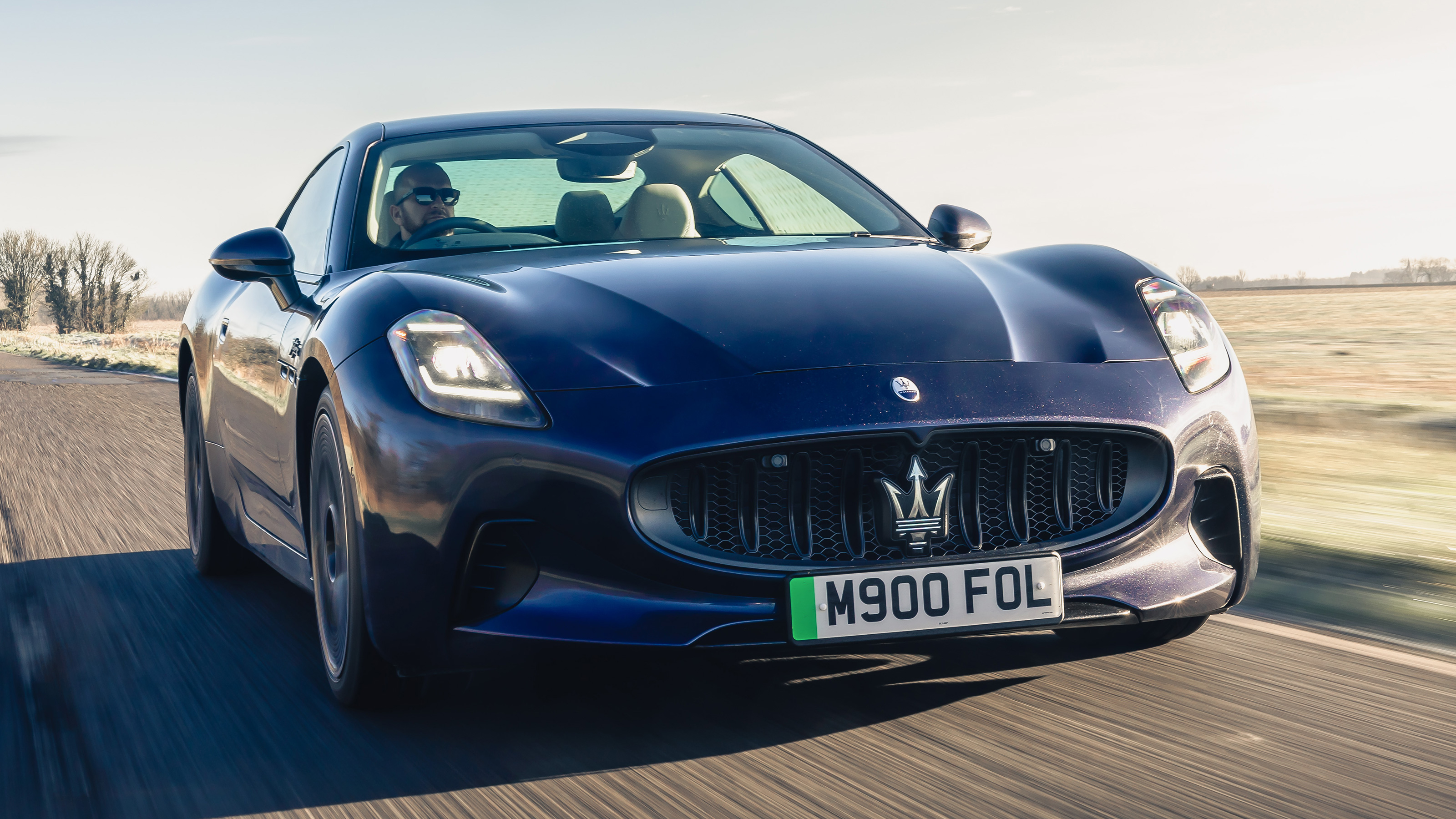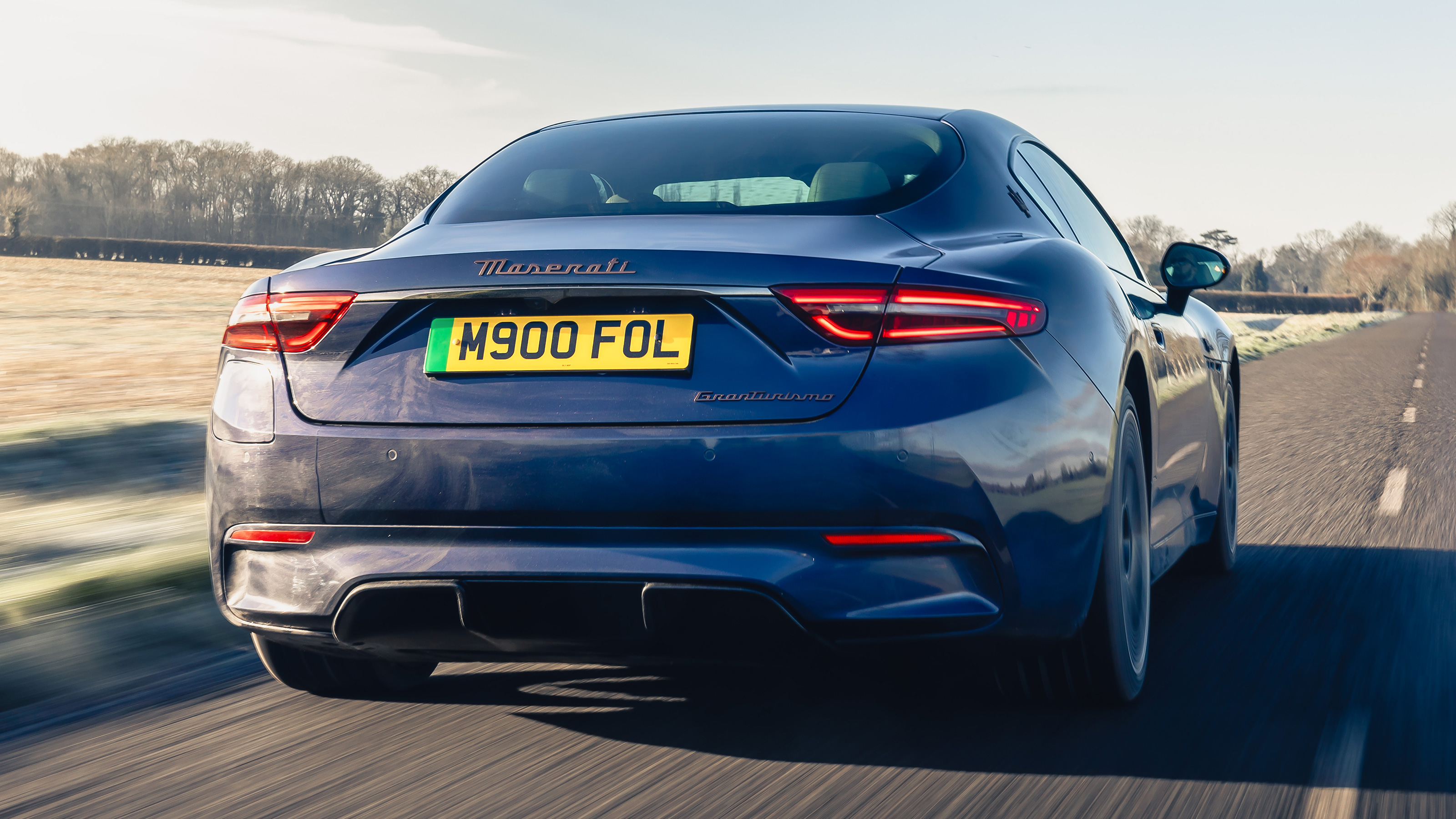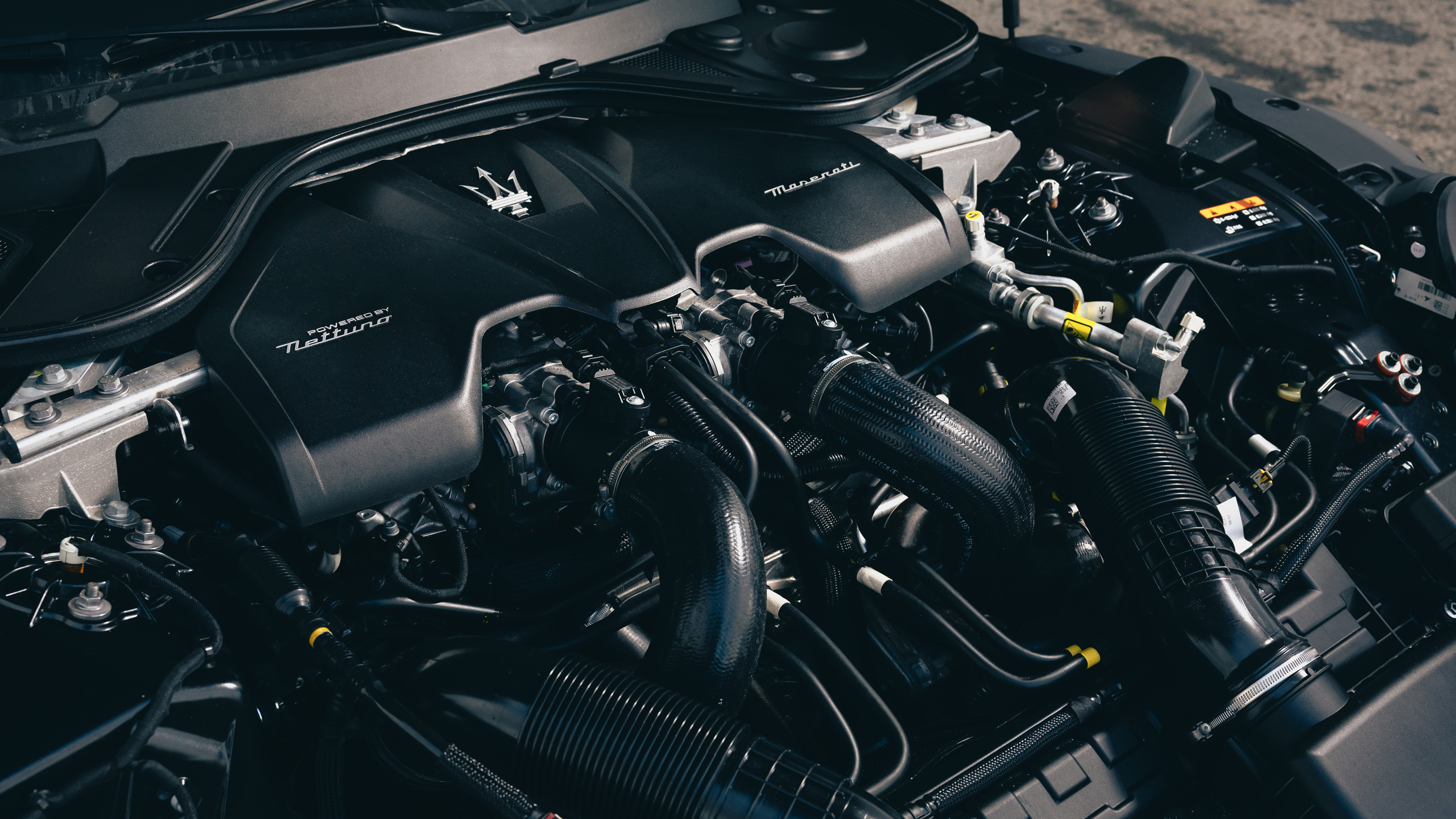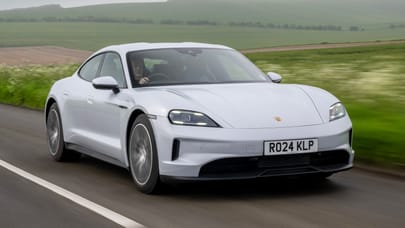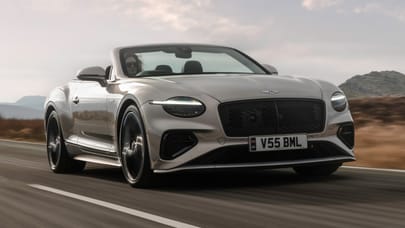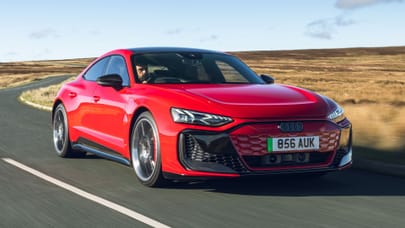
Maserati GranTurismo review
Good stuff
Looks great, two excellent powertrains, electric Folgore version is a TG award winner and probably the pick of the bunch
Bad stuff
Only the petrol can be a proper grand tourer, V6 can’t match the sound of the old V8
Overview
What is it?
An all-new Maserati, even if it bears a passing resemblance to the old one that was around for 15 years. It comes in all-electric form to boot, as well as petrol. Those are, for an EV, unusually long-nose proportions. But it needs to be that way to have room for the petrol version's V6, and anyway that snout looks fabulous.
It’s very definitely a grand tourer in the traditional mould though. Maserati has history since the late 1950s of building GTs. Some have been pretty spotty, sure, but the best of them were bang-on for driving a long way fast, and looking cool while doing so.
So that's the GranTurismo: desirability and exclusivity to approach a supercar's, but front-engined and softer, so you have fewer of the mid-engined compromises in space and comfort. The GranTurismo is a real four-seater.
And now it’s gone electric? Batteries are famously not good for going a long way at uninterrupted high speed. But who uses a grand tourer to do that any more? If you do, don’t panic, Maserati is here to help. There's a petrol version. Keep reading.
So it's an EV?
One version is. It’s called the GranTurismo Folgore and it’s Maserati’s first ever pure EV. Folgore roughly translates as lightning or thunderbolt, and a similarly-named version of the MC20 supercar will follow the Grecale Folgore SUV that landed in 2024. In fact, all Maseratis will have an electric version by the end of 2025. And by 2030 there will be no more petrols.
But there's a petrol alternative too?
Correct. The GranTurismo's combustion version has the MC20’s 3.0-litre twin-turbo ‘Nettuno’ V6 motor and a ZF eight-speed auto gearbox with 4WD. The engine uses a wet sump here as opposed to the dry sump in the MC20, and produces 483bhp in the entry-level Modena version and 542bhp in the more aggressive Trofeo.
Chicken feed. The electric one develops 750bhp. It has three 400bhp motors, two at the back and one up front. Why, then, not 1,200bhp? Because the inverter and battery can't put out that much electrical power, so the available 750bhp is distributed among the wheels the brain thinks can make best use of it. Which – if you click the Driving tab of this review – you'll see works well.
Sounds good. Why is the styling so safe?
Partly because petrol dictates the packaging and necessitates the long bonnet (although the Nettuno V6 is so compact that Maserati has been able to stick a diff in front of it). But mostly because Maserati is rebuilding its brand and doesn’t want to alienate existing customers or try anything too radical. Consistency is a mark of premium brands. The old GranTurismo was loved for its styling almost above all else, so it made sense not to lob that overboard.
Compared to the old GranTurismo, the obvious change is the switch to vertically-placed headlights but actually it's all different. It’s a handsome machine, and a very large one. The wheels, 21-inchers at the back, are a touch too much tucked under the body, which emphasises the size. The huge aluminium clamshell bonnet gives the front end real presence.
You can play spot the difference with the petrol and electric versions – the former has a slightly redesigned face with more cooling, plus there’s a little lip spoiler and those four all-important tailpipes at the rear. The EV ditches the exhausts for obvious reasons, and gets ‘Folgore’ badging and specific wheels - it really doesn’t shout about the electric motivation.
Where's the battery in the Folgore?
Ah, you’ve realised there’s not enough room underneath the car. When we first saw the Folgore (pronounce it Fol-go-ray, by the way) we assumed they’d done away with the back seats. But no, they’re intact.
Instead, this all new, mostly aluminium platform sites the battery in a similar position to the petrol powertrain. It sits in an inverted ‘T’ across the car in front of the driver, and then runs up the transmission tunnel.
Doesn't that make it very nose heavy?
Well, Maserati claims a 50:50 weight distribution for the Folgore, and our bum telemetry tells us understeer isn’t an issue. It doesn’t have huge amounts of grip, but the balance between front and rear is deft.
We've driven the petrol Trofeo on roads in Italy and the UK and the Folgore on track in the motherland and on real – wet and icy – roads in the UK. In both, the suspension isn't punishingly hard, with the Folgore revealing a wonderful compliance when you’re just trickling along. Proper GT comfort, if a little bit taut when compared to something like a Bentley Continental GT. In fact, the electric Maserati is probably closer to something like an Aston Martin DB12. Just a bit more sporty. There’s a hint of roll in both versions of the Maserati, mind – it looks like quite a lot in the pictures, but it doesn’t feel that way because it’s well managed and controlled. In fact, at most speeds the GranTurismo exhibits the same fluent, together, composed behaviour as the MC20 supercar.
Which is faster, petrol or electric?
Depends how you’re evaluating them. In a straight line electric beats petrol: the Folgore’s 2.7 seconds to 62mph plays 3.5s for the Trofeo and 3.9s for the Modena. Maserati has geared the electric not to let up any time soon, either. It reaches 124mph in 8.8s and top speed is ‘over 199mph’.
Lap times are much closer. That's down to the simple fact that the petrol is 450kg lighter than the 2,260kg Folgore. But there’s more to it than just weight; the Folgore is very good at torque-vectoring between the three motors, and that counts for a lot on an actual road. It also disguises that weight very nicely, something a lot of EVs just can’t manage. And as for chequered flag shenanigans, they’re not exactly your usual track-day toys anyway.
What about range then?
Well, it’s not going to be good in either version if you’re doing 199mph. However, Maserati is claiming 280 miles WLTP from the Folgore battery’s usable 83kWh capacity, which equates to EV efficiency of 3.4 mi/kWh. You’ll only get that by going gently in ideal circumstances, but it’s a decent claim for a car of this weight, wearing 265 front and 295-width rear tyres and boasting a less-than-exceptional 0.26Cd drag factor. On a wet and cold few days in the UK, we got 1.9mi/kWh, but there were some enthusiastic testing sections. Realistically, you’re looking at about 220-230 miles per charge.
No matter how much Maserati bangs on about 800V architecture and 350kW recharging meaning 10 minutes on charge can add 100 miles, we all know the reality of the charging infrastructure. You’ll enjoy the journey between stops though.
Even if you’re not going to be smashing out France on a one-stop strategy, the Folgore is very quiet on the move. It feels together and easy to drive. A car you’d be happy driving a long way.
The petrol-powered versions are equally as relaxing to drive in a non-enthusiastic manner. But heck, this is a circa 500bhp Italian sports car too, we want enthusiasm!
Hang on, how much does it cost?
Ah. Yes. Erm. Well. The new GranTurismo is not a cheap car. The Modena starts at £133,000, the Trofeo costs (an oddly specific) £163,470 and the Folgore is £180k. Thankfully the DB12 has arrived to make it look like a bargain.
Our choice from the range

What's the verdict?
The new GranTurismo has a warm and generous character. It knows what it is: a GT for real life. Too many coupes this price are over-compromised by a notional need to be capable on track.
It's an engaging, well-engineered and well-executed car with enough of an edge and a hint of drama to convince as a genuine Maserati. In tune with all those that have gone before, but more polished and capable.
The electric Folgore could give its future rivals a proper headache. Currently only Porsche’s revised Taycan, possibly the Audi e-tron GT and the (LHD-only) Tesla Model S Plaid might count. But in due course Bentley, Aston Martin and we must assume Ferrari will pile in. That’s the market area Maserati is pitching itself into now. This is a car that has real cachet, that feels, acts and drives expensively and comes across as better engineered and developed than any Maserati in living memory.
The petrol Trofeo is really likeable for everyday drives and special long ones. A Bentley feels heavier and more formal, a 911 beautifully engineered but actually a little one-dimensional in comparison, and just a two-seater really. A BMW M8 has a bit of an identity crisis – it's a bit harsh as a GT – and in any case is just a big fast version of the other BMWs. The DB12 is the best Aston we've driven in years, and is priced as such. But this Maserati? It's special.
As a company it has momentum and investment behind it right now. The wonderful MC20 is a halo, and the SUVs will sell in bigger numbers. But this is Maserati’s signature dish. And the GranTurismo Folgore bodes ever so well for the electric versions of Maserati’s future cars.
It’s got there ahead of rivals with an emissions-free sports car, which means it sets the tone and expectations for everyone else. But it’s also offering a blisteringly fast and engaging petrol option too. It’s a powerful position to be in. Everyone else is playing catch up. And this is going to take some catching.
The Rivals
Trending this week
- Top Gear's Top 9
Here are nine of the coolest car nicknames




